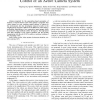Free Online Productivity Tools
i2Speak
i2Symbol
i2OCR
iTex2Img
iWeb2Print
iWeb2Shot
i2Type
iPdf2Split
iPdf2Merge
i2Bopomofo
i2Arabic
i2Style
i2Image
i2PDF
iLatex2Rtf
Sci2ools
ICARCV
2008
IEEE
2008
IEEE
Looking at the surprise: Bottom-up attentional control of an active camera system
—Inspired by the expectation-based perception of humans, a surprise-driven active vision system is proposed. This vision system not only considers spatial saliency of objects in the environment, but also investigates temporal novelty in the neighborhood. Surprise is defined as the difference of the saliency probability distributions of two consecutive input images, which is measured using Kullback-Leibler divergence. The high-speed gaze shift capability of the camera platform and the parallel computation with the aid of GPUs enable a real-time tracking of the surprising event.
Consecutive Input Images | ICARCV 2008 | Robotics | Saliency Probability Distributions | Surprise-driven Active Vision |
| Added | 30 May 2010 |
| Updated | 30 May 2010 |
| Type | Conference |
| Year | 2008 |
| Where | ICARCV |
| Authors | Tingting Xu, Quirin Mühlbauer, Stefan Sosnowski, Kolja Kühnlenz, Martin Buss |
Comments (0)

